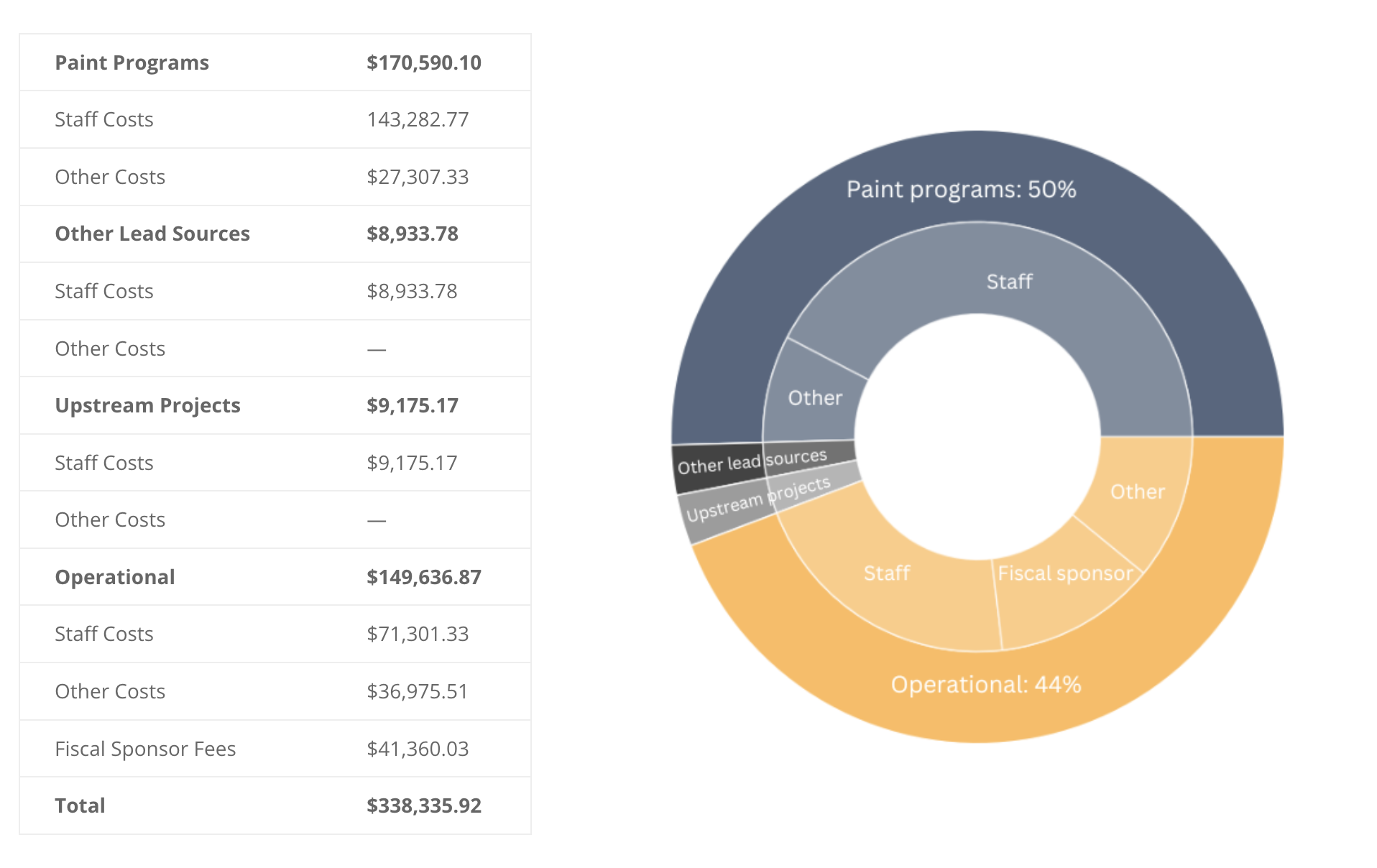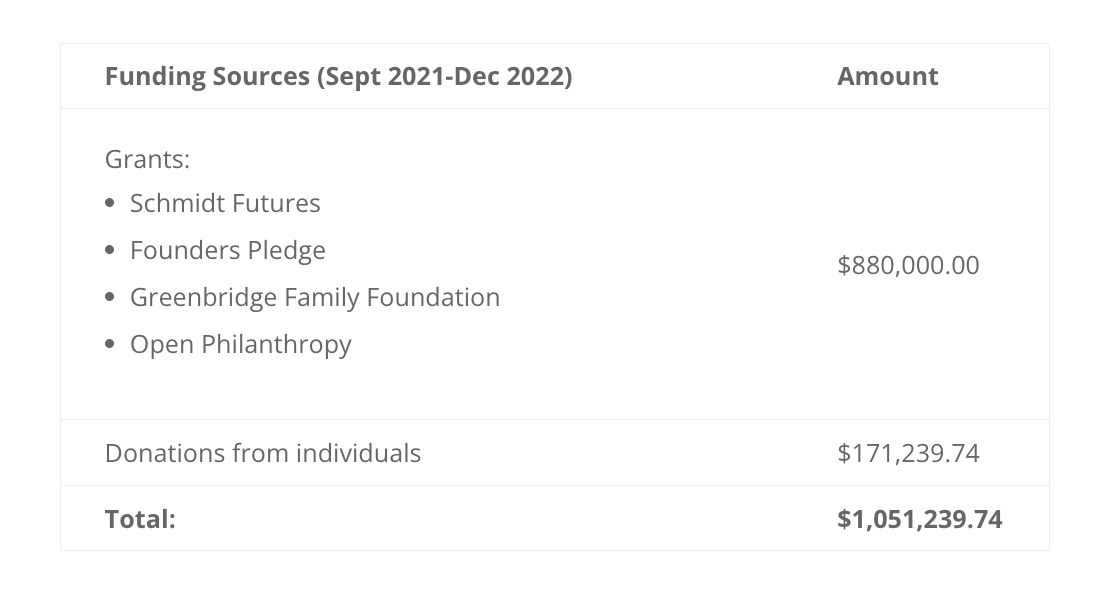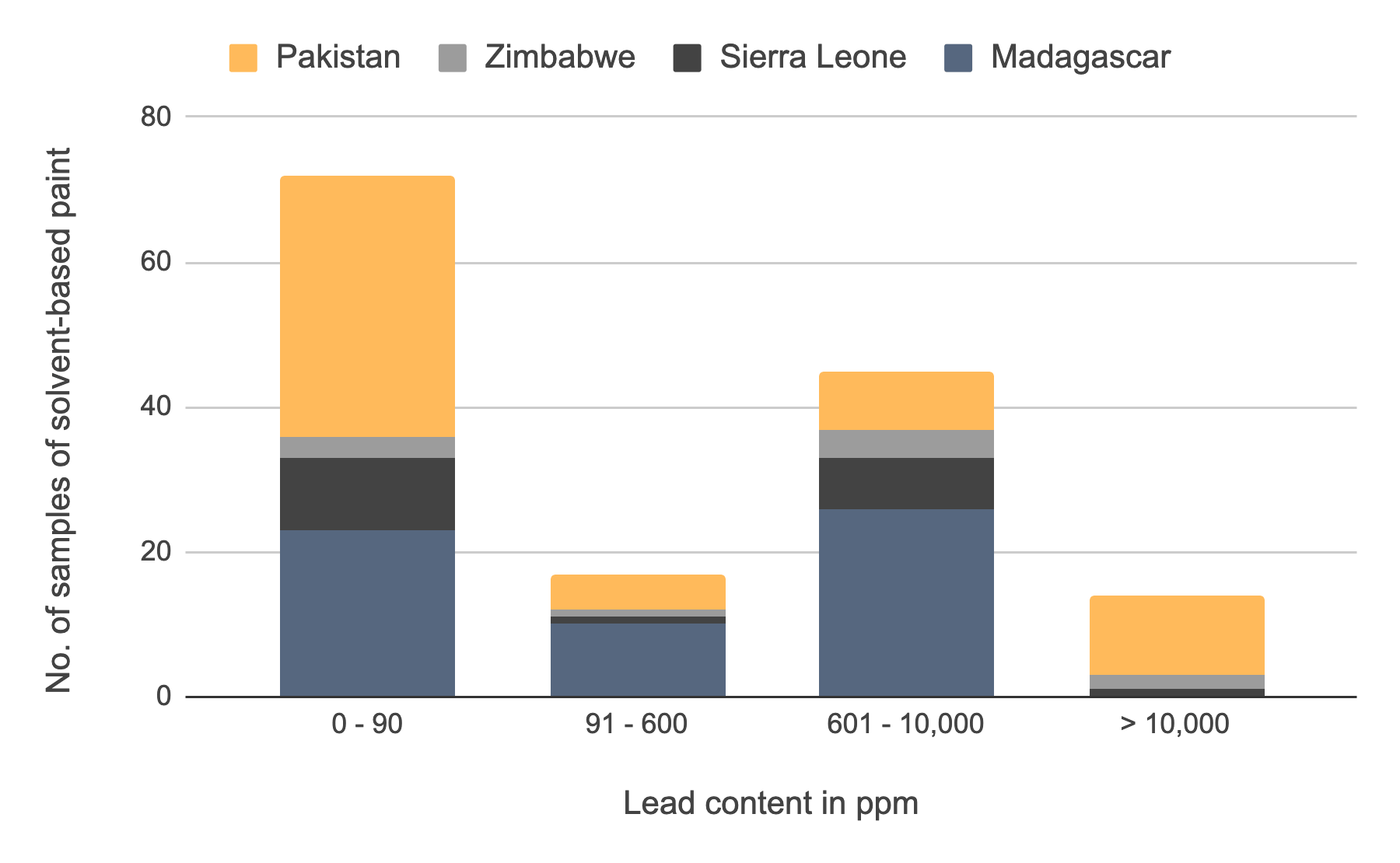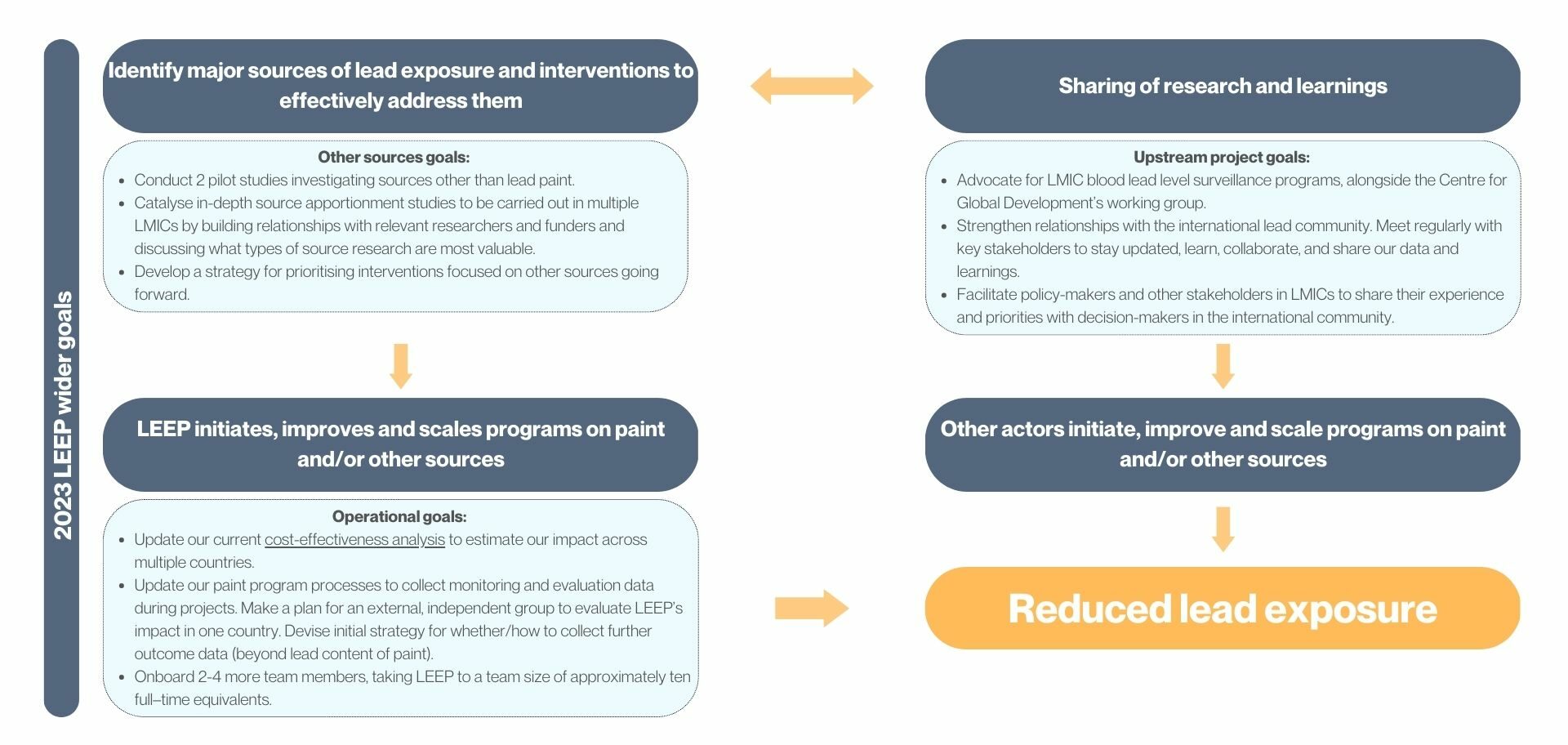Introduction from LEEP’s Co-Executive Directors
LEEP was founded on an ambitious goal: to improve the health, wellbeing, and potential of as many children as possible. This goal has always been grounded by the belief that progress is possible if we are committed to being impact driven, collaborative, and evidence based. And indeed, the last 16 months have seen major progress, both in terms of the steps we have taken towards reducing lead exposure, and our growth as an organisation.
We have expanded our paint programs, which aim to end the availability of lead paint, from three to ten countries. In each of these countries, exciting advances are being made towards the goal of reducing childhood lead poisoning. Madagascar introduced a new standard limiting the lead content of paint after LEEP and government partners conducted a study that found high levels of lead paint on the market. Zimbabwe and Sierra Leone are also both taking steps towards regulation, spurred on by LEEP’s support with paint testing. In Malawi, monitoring of lead in paint has begun and manufacturers have been working to reformulate their paints. These steps forward have laid the groundwork for even greater progress towards eliminating lead paint in 2023.
With our underlying mission to eliminate all lead exposure, not just lead paint, we have begun investigating other sources of exposure to identify cost-effective and impactful interventions, and have initiated our first study on lead in spices. We have also been delighted to increase our involvement in the global community of organisations working to reduce lead exposure by sharing our data and learnings at a G7 workshop and in the Center for Global Development’s working group.
Of course, it’s the team that makes this all possible. LEEP has undergone significant growth as an organisation this past year. Over 2022, six new members joined our team: Julia Berg as Head of Operations; Bal Dhital, Charlie Loudon, and Charlotte Potts as Program Managers; Guillermo Olmedo Mendez as Bolivia Program Lead; and Nasser Hassane as Research Assistant. We’re delighted to have gained a talented team who are passionate about LEEP’s mission and committed to its realisation.
Amid this expansion has come other changes: our colleague and LEEP’s co-founder Jack Rafferty recently moved from a director to an advisory role with LEEP. Jack has had a major impact by co-founding LEEP, as well as by launching a number of paint programs, leading LEEP’s operations, and by setting a positive culture and overall ambitious strategy. His energy, entrepreneurship, and dedication will be missed from the day-to-day operations, but the team looks forward to his continued input as a member of the advisory board.
Throughout this period of growth and change, LEEP’s mission and methods remain the same. We are committed to reducing childhood lead poisoning, and we believe that doing so requires a prioritisation of impact, evidence, and collaboration with global partners. With one in three children estimated to have lead poisoning, our work is far from over. But we believe our progress so far demonstrates that change is possible.
Thank you to everyone who has supported us over this exciting period of growth.
Lucia and Clare
Our work: September 2021 – December 2022
In this section, we describe work carried out in Year 2, as well as during the last four months of 2021. We are covering this 16-month time period because, for convenience and clarity, we decided to change LEEP’s internal year to match calendar years.
Initiated paint programs
As laid out in the theory of change below, our paint programs aim to reduce the use of lead paint, thereby reducing lead exposure, and improving children’s health and wellbeing.
- We started paint programs in seven new countries: Pakistan, Sierra Leone, Liberia, Niger, Angola, Ghana, and Bolivia. These countries were at various stages of the regulation process when we began our programs in each of them. Some had, to our knowledge, no current activity towards regulation, while others had begun the process but encountered barriers that we could assist with.
(Click to enlarge) Figure 1: Theory of change for our paint programs.
Completed paint studies
Generating data on the lead content of paint in a country is a key step in many of our paint programs. The data motivates and informs the development and enforcement of regulation. Support with paint studies is often a main request from our government partners. Paint studies also allow us to prioritise countries with the highest levels of lead paint, identify which manufacturers might benefit from technical support, and evaluate the progress towards a market free of lead paint through follow-up studies.
- In collaboration with academic or government partners we completed four new paint studies, and shared the results with key stakeholders, on our website, or in an academic publication.
- As shown in the summary of the results below, high levels of lead in oil-based paints are still common in each country. We also found that red and yellow oil-based paints are more likely to contain lead than white ones. This is because red and yellow pigments (which are used to make a variety of colours) are often the source of the lead.
(Click to enlarge) Figure 2: Paint study data from four countries.
Supported governments in implementing lead paint regulations
We aim to have close communication with our government partners so that we can assist both technically and financially throughout the process of implementing lead paint regulation. In addition to paint studies, other support has included:
- Providing funding for multi-stakeholder meetings.
- Sharing educational and technical resources related to lead paint regulation, such as information around testing, examples of lead paint laws, and existing research.
- Helping repair paint-testing equipment.
- Providing funding for external lab testing so governments can validate their internal testing.
Following our paint studies and, in some cases, other support, we were delighted that the relevant government agencies or ministries in Madagascar, Sierra Leone and Zimbabwe shared with us their intention to introduce lead paint regulation. We also made progress formalising our collaborations by signing Memoranda of Understanding with the Sierra Leone Environment Protection Agency; the Ministry of Public Health, Population and Social Affairs of Niger; the Ministry of the Environment and the Fight Against Desertification of Niger; EcoAngola; and National Institute of Environmental Management in Angola.
Provided technical assistance to help paint manufacturers switch to non-lead paint
By supporting paint manufacturers with technical assistance to switch to non-lead ingredients, we aim to increase industry’s support for new regulation, and to improve compliance, particularly in areas where enforcement capacity is limited.
- We engaged with manufacturers in two countries and four manufacturers told us they were reformulating their paints. Two of these manufacturers had taken up our offer of free reformulation consultations with Philip Green, LEEP’s paint technologist.
Upstream projects and other sources of lead exposure
Paint programs are our focus, but we have always had our eyes on the ultimate objective: a world without lead poisoning. There are several additional, potentially impactful avenues to this goal, including eliminating lead from non-paint sources, and effecting change on a more macro level. This year, we pursued several projects toward these ends:
- We started investigating other sources of lead exposure, published a related blog post, and started a small study testing spices for lead in Turkey.
- We presented at a G7 workshop on lead as a major threat for human health and the environment and we are participating in CGD’s working group on the Global Burden of Lead Poisoning.
- We wrote a proposal for the US government and spoke with USAID’s DHS survey about including blood lead level testing.
- We calculated an update to Attina and Trasande (2013)’s study on the economic impact of childhood lead exposure in low- and middle-income countries.
- We contributed towards Our World in Data’s series on lead pollution.
Operations and team growth
To enable the expansion of our work, LEEP’s team and operations grew:
- We hired a Head of Operations, three Program Managers, a Bolivia Program Lead, and a Research Assistant for our project in Niger.
- In June 2022, LEEP was granted 501(c)(3) nonprofit status by the Internal Revenue Service.
Recognitions
LEEP’s work was publicly highlighted for its expected impact and cost effectiveness:
- Our co-founders, Lucia Coulter and Jack Rafferty, were selected for Vox’s inaugural #FuturePerfect50, a list of 50 scientists, thinkers, scholars, writers, and activists building a more perfect future.
- Founders Pledge recommended LEEP as a high-impact funding opportunity to its members, in August 2022.
- Giving What We Can now lists LEEP as a top-rated charity.
Did we meet our goals?
Overall, we made good progress towards the goals we set in September 2021 for the following 12-month period. A summary can be found here, showing that two goals were completed, and two were mostly completed. We also share our OKRs for the same time period.
Key metrics and impact
The table below summarises the status of our paint programs. Each column is an indicator of progress towards the outcome of reduced lead paint available on the market, and links to our theory of change (see graphic in ‘2023 goals’ section).
(Click to enlarge) Figure 3: Summary of paint program statuses.
*We are currently unable to share identifying information on the second country for this category.
**The paint study we conducted in Botswana in 2021 found that levels of lead were less than 100 ppm in all samples. We deprioritised work in Botswana as a result of these findings.
Cost-effectiveness and total impact
In last year’s annual review, we shared our preliminary cost-effectiveness model of LEEP’s Malawi program. We estimated that the cost to avert one ‘Disability Adjusted Life Year-equivalent’ through this program is $14 (90% confidence interval: $6-47/DALY-equivalent). The model rests on various assumptions and should be interpreted cautiously.
Founders Pledge conducted their own analysis, taking into account the countries we are currently working in. Founders Pledge estimated that LEEP’s work costs $1 to prevent one child’s lead exposure (in expectation). They write: ‘As of August 2022, that makes LEEP one of our most cost-effective charities.’
As we grow and our spending increases, it becomes more and more important to evaluate our impact and cost effectiveness. We have not updated our model since last year; doing so is a key goal for 2023, as is further developing our monitoring and evaluation practices.
2023 Goals
Our goals for 2023 are summarised in the following graphics. The top half of the first diagram shows the theory of change for our paint programs; the bottom half shows our 2023 goals, which, if met, indicate progress towards the outcomes in our theory of change. We plan to expand our paint programs from 10 current projects to 17 by the end of the year. We also hope to achieve government commitments to regulate lead paint in five more countries and receive reports of manufacturers switching in three more countries.
The second diagram shows our 2023 goals in areas other than paint programs (other lead sources, ‘upstream projects’, and operational), as well as how they relate to one another and our mission to reduce lead exposure. The overarching themes are to test out programs on other sources of lead exposure, to be a voice and an amplifier of voices in the global lead community, and to improve our own strategy and evaluation, in particular by working on our cost-effectiveness analyses and monitoring and evaluation.
(Click to enlarge) Figure 4: Goals for our paint programs in 2023, and how they correspond to our theory of change.
(Click to enlarge) Figure 5: Goals for our other work in 2023.
Financials
Expenses:
In the 16-month period covered by this Annual Review, we spent a total of $338,335.92.

A comparison of our Year 2 (Sept 1-Aug 31, 2022) budget to our actual spending from that same period can be seen here. While we had budgeted $281,731.39 for this period, we ultimately spent $193,211.45. This can be partly accounted for by hiring later than initially planned. We also spent less than we budgeted in most expense categories, including paint study costs, in-country partnership officers, and other program costs.
Our estimated budget for 2023 can be seen here: it totals $1.26 million, reflecting the recent growth of the LEEP team and the number of countries we are hoping to support in 2023.
Funding

Learnings and reflection
In this section, we briefly describe some lessons learned over the period of this review and explain how our thinking is developing on some strategic considerations for LEEP.
We’re more confident that our paint programs are working
Our confidence in the impact of our paint program intervention has grown over the last 16 months. We have been able to engage and make progress with governments in countries where there was no existing momentum towards lead paint regulation. We have also seen more clearly how LEEP’s technical and financial support can catalyse progress in countries where there are already existing efforts towards regulation. An example of the latter case is Madagascar: Rila Rakotomanana at the Ministry of the Environment and Sustainable Development wrote that “LEEP’s involvement has made a big difference because they have helped us test the lead content of paints. This is a game-changer because the results of these tests will help us to advocate with decision-makers and prove the lead content of paints in Madagascar.”
Lead paint became a more neglected problem globally in 2022
In the summer of 2022, the Global Alliance to Eliminate Lead Paint’s SAICM GEF project–which worked with 40 countries towards legislating and implementing legislation to restrict the use of lead in paint–came to an end. Although the Alliance continues to exist, it no longer has funding to directly engage governments and industry. While we advocate for re-funding the Alliance, this leaves an even larger gap for LEEP’s work. We think that lead paint, and lead exposure generally, remain neglected issues where LEEP can have a cost-effective impact.
Close and frequent communication makes a big difference
The importance of working closely with our partners in government continues to be a vital lesson. Frequent meetings and regular exchanges of messages have proved essential for developing an understanding of their changing needs, and for offering flexible support or guidance accordingly. As LEEP scales and our team grows, it’s important to make sure we maintain this close communication. We plan to ensure that our team has enough capacity for regular contact and some in-person meetings, often bolstered by working with a local consultant or partnering with a local organisation (typically an NGO or academic institution).
Signatures can matter
We’ve gained a greater appreciation for the importance of understanding the organisational process and structure in a given ministry or agency, and of formally signing a project agreement or memorandum of understanding with the relevant senior officials. We have been putting increased emphasis on formalising the relationship in this way, which helps to make certain that all parties have a shared understanding of the next steps. It may also make our partnerships more robust to personnel changes and more flexible for ongoing work with different departments as a project progresses through regulatory and enforcement stages.
We should have hired faster
By spring of 2022 we had initiated six new paint programs and our three-person team was very stretched. We weren’t able to provide the level of engagement and support to our partners that would have allowed the most efficient progress. As a response, we ran hiring rounds for the programs team and a Head of Operations over the summer. Ideally, we would have run these sooner, in order to be able to provide the level of support we aspired to all through 2022. Reflecting on this, the delay occurred for a mixture of reasons: we wanted confidence that we shouldn’t significantly adjust our program model before committing to a certain team structure, we wanted to have more secure funding, and also (counterproductively) we felt too busy to put time into hiring. With significant team expansion at the end of 2022, we now have capacity for both a greater depth and breadth of support.
We learnt more about the paint industry perspective
From speaking with paint manufacturers, as well as with Philip Green, LEEP’s consultant paint technologist, we are deepening our understanding of the barriers manufacturers commonly face to remove lead ingredients from their paints.
- Cost: The change in cost depends on the specifications of the paint, but for brightly coloured oil-based paints with some “high-performance” specifications, the cost could increase by roughly 30-50%. Other paints will remain similar in cost. Some manufacturers don’t want to “go first” and be disadvantaged in the market relative to others. Creating a level playing field with well-enforced regulation helps to solve this problem.
- Expertise and capacity: Some smaller companies don’t have an in-house chemist or formulator who is able to devise and perfect a new formula with the same characteristics as the existing paint. Even when they have the expertise, finding suppliers and testing the new paint can take many months. We can help by providing free consultations with a paint technologist, providing technical resources on reformulation, sharing learnings from other smaller companies that have successfully reformulated, and putting them in touch with possible suppliers.
There’s a tricky balance between focus and exploration
So far, LEEP’s work has almost exclusively focussed on paint. This is because we believe paint is a well-evidenced source of exposure, and is tractable to address, resulting in a cost-effective program for LEEP to run. We always remain open to re-evaluating our position if new evidence comes to light, as well as to working on other sources of exposure. Whilst we aim to run highly cost-effective programs, we also want to increase our total impact. Given that, and some existing evidence that other sources of exposure, like spices, could be cost effective to address, we have started to explore expanding our programs beyond paint. However, we are also conscious of not stretching ourselves too thin, particularly as we grow. During the period of this review, we spent roughly 4% of senior staff time on other sources work (compared to 68% on paint), and we plan to expand this to roughly 8% in 2023.
Another area of focus is on “upstream” projects – which we define as being at least one step further removed on the causal chain from reducing lead exposure than LEEP’s direct work with LMIC governments and manufacturers. Examples include advocating for more blood lead level surveillance or catalysing source apportionment research. Again, we are wary of losing focus as an organisation, in case it leads to poorer execution overall, but it’s very possible that more impactful projects (than our core paint program) exist. Our general approach is to prioritise projects that are a good fit with our approach (working closely with stakeholders at the country level) and our values (commitment to evidence and impact). During the period of this review, we spent roughly 4% of senior staff time on other upstream projects; in 2023, we plan to keep this roughly the same.






